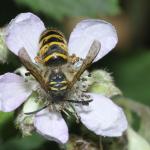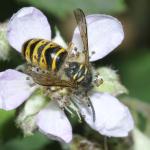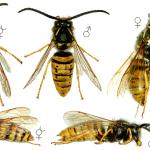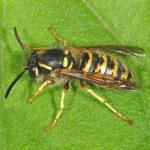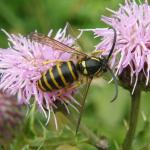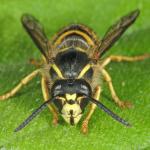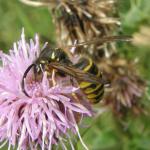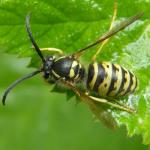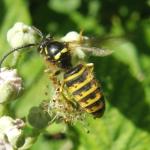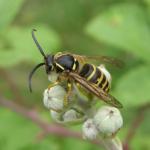Vespula bavarica VON SCHRANK 1802; Dolichovespula kamtschatkensis ECK 1983; Dolichovespula nigrescens ECK 1983; Dolichovespula nipponica YAMANE 1975; Vespula tridens SCHENCK 1853
Specimens of the 'Saxon wasp', the second species of social wasp to have recently colonised England, are more difficult to identify in the field than its congener D. media. It is a very close relative of D. norwegica but lacks the pair of red spots on the second gastral tergum (but beware, these markings are also absent in some D. norwegica).
The first British record of this wasp was a male collected in the grounds of Juniper Hall Field Centre, near Dorking, Surrey, in July 1987 by G W Allen (in Hammond et al., 1989; Allen & Archer, 1989). In 1990 the species was reported from Norfolk. Further specimens were encountered in West and East Sussex (including the first nests of this species to be found in Britain), and Norfolk in July and August 1991 (Colvin, 1992). At the end of the 1995 season, the species occupied much of south-eastern England (see also Irwin, 1991; Else, 1993c). It is very likely to extend its range much further in Britain in the future. In some areas, it is locally common. For example, a house in Wotton, near Dorking, Surrey, in 1995, had two nests of this species under the eaves, another in a garden shed and possibly two others in the roof (J D Holloway, pers. comm.). In 1993, 22 nests were reported from the Royal Horticultural Society's gardens (about 100 ha) at Wisley, Surrey (A J Halstead, pers. comm.) (the species was first found there in 1992, when two nests were discovered). Indeed, at Wisley it was the commonest wasp which nested there in 1993, far outnumbering Vespula vulgaris.
Not listed in the Red Data Book, but placed in the Insufficiently Known category (pRDBK) in Falk (1991). In view of the recent expansion of its range, this status should be revised.
This wasp has been found in both urban and rural areas within south-east England. The species seems to be particularly widespread on heathland in West Sussex and North Hampshire (M Edwards, pers. comm.).
No published records in Britain, but probably April-August.
Nests occur in aerial locations. There are records of them suspended from the branches of bushes, from beneath the eaves of houses (sometimes in quite built-up areas) (Colvin, 1992), beneath rafters and roofs in barns and sheds, under a park bench, on the sides of buildings, and in a cavity wall. The nest paper is generally pale grey, being built from fibres apparently collected from sound, weathered wood. The nest entrance usually has a thick, lip-like rim. A nest beneath the eaves of a house has been illustrated by Colvin (in Else, 1991).
In the spring, queens have been seen visiting the flowers of bilberry and, in the late summer, workers and males have been collected from wild angelica, wild parsnip and hogweed blossom.
1997


